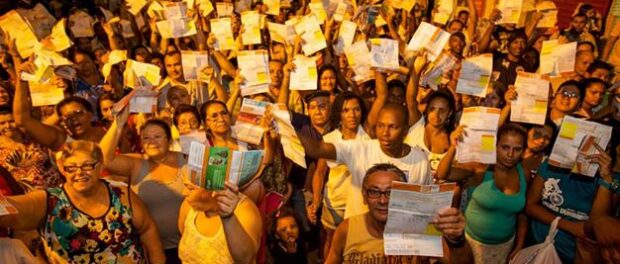
Light Serviços de Eletricidade S.A. (Light) has long provided electricity–officially and unofficially–to Rio’s favelas. With the installation of Pacifying Police Units (UPPs) (the police occupation of a number of favelas over the past 5 years) Light began to regularize their services and deal with the historic problem of gatos, as clandestine connections of electricity are known in Rio. Yet increasingly, residents of UPP-occupied favelas complain of monthly bills rising inexplicably to abusive prices, a lack of public illumination, as well as blackouts and failures in the service. RioOnWatch has investigated cases of problems with Light’s electricity service in UPP-occupied favelas, finding worrying evidence of systematic irregularities and abuses on its part.
Rising bills
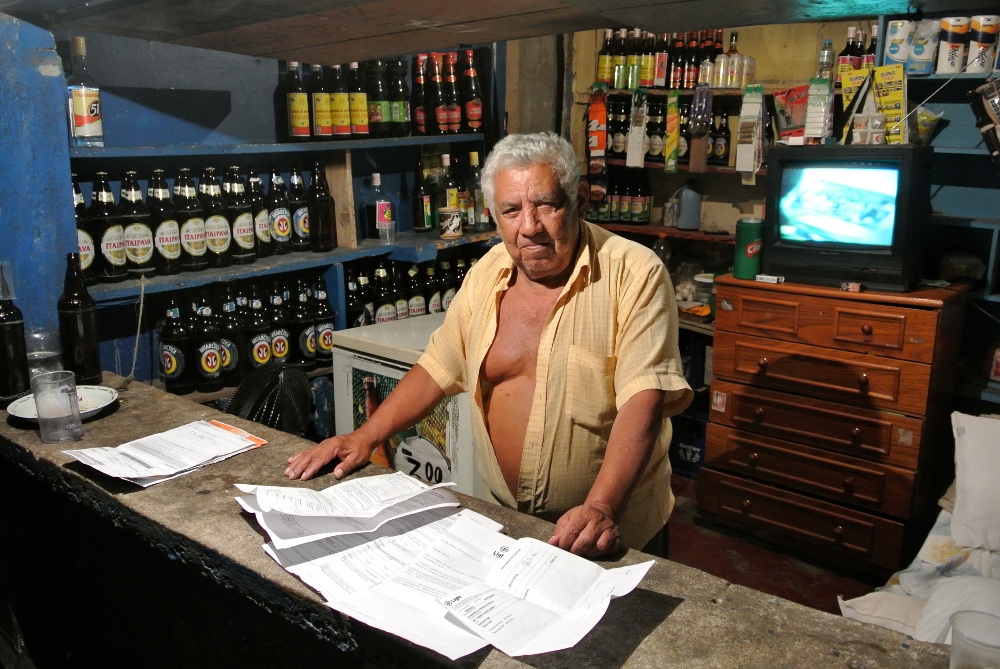 79-year-old Fransico Vieira da Silva–better known as Sr. Chico–sits in his birosca in Santa Marta, a modest bar run out of the back of his house, containing little more than a fridge, freezer, TV, fan and some simple furniture. High up, overlooking the evening lights of Botafogo and Lagoa, he holds an electricity bill for R$3,321 (US$1500).
79-year-old Fransico Vieira da Silva–better known as Sr. Chico–sits in his birosca in Santa Marta, a modest bar run out of the back of his house, containing little more than a fridge, freezer, TV, fan and some simple furniture. High up, overlooking the evening lights of Botafogo and Lagoa, he holds an electricity bill for R$3,321 (US$1500).
A 60-year resident of Santa Marta, he is now retired after working for the minimum wage his whole life. Before the entrance of the UPP in 2008, and the subsequent regularization of the electricity service, he used to pay a basic monthly rate of R$18. Once the UPP entered, “I always paid R$70 or R$80, and it would always rise a little.”
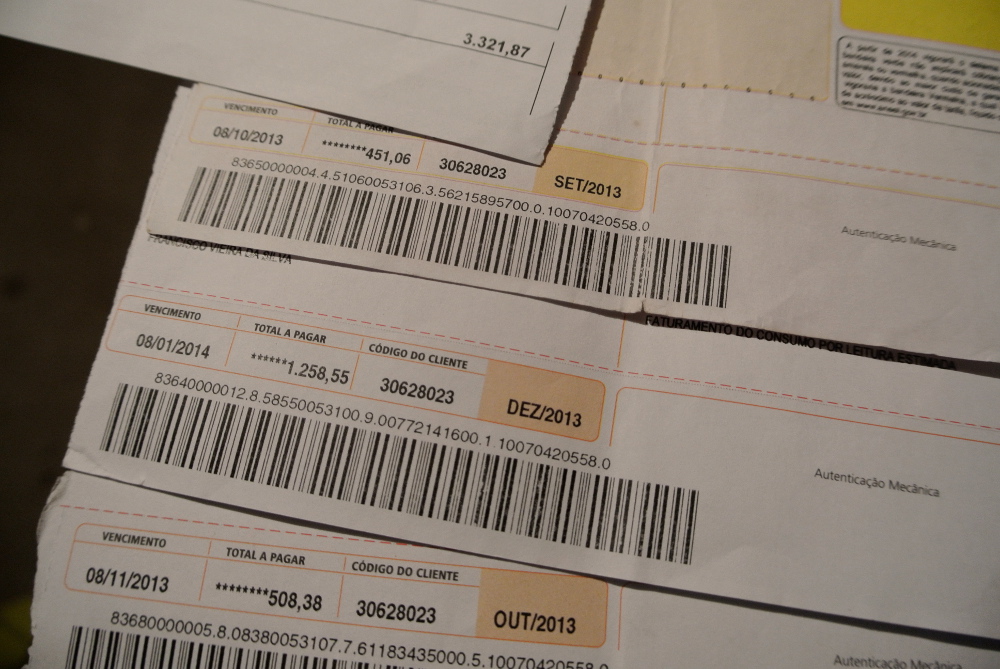 In 2013, this figure started to rise dramatically into the hundreds–well beyond his financial capability. In October, he received a bill of R$451, followed by R$508, and R$1,258 in December–with no corresponding rise in consumption. After local activists made a film about his case, representatives from Light assured him he didn’t need to pay this latest bill, and that a technician would come to check his meter. Not long after, with the technician still elusive, the bill of R$3,321 arrived–without explanation or justification of such an extraordinary sum.
In 2013, this figure started to rise dramatically into the hundreds–well beyond his financial capability. In October, he received a bill of R$451, followed by R$508, and R$1,258 in December–with no corresponding rise in consumption. After local activists made a film about his case, representatives from Light assured him he didn’t need to pay this latest bill, and that a technician would come to check his meter. Not long after, with the technician still elusive, the bill of R$3,321 arrived–without explanation or justification of such an extraordinary sum.
The case of Sr. Chico is but one extreme example of what we have witnessed commonly occurring across pacified favelas. Residents look on incredulously as their electricity bills rise exponentially, regardless of their consumption. This comes alongside common reports of the absence of public illumination, blackouts, electrical fires, and perhaps most painfully, the lack of any explanation or assistance from Light itself.
Historic problems
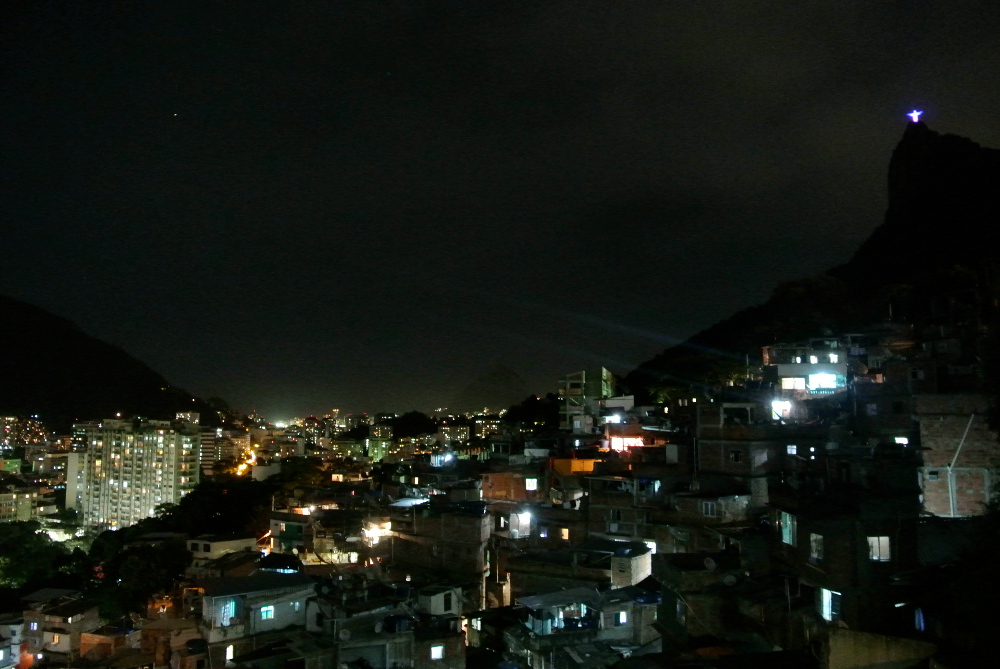 Privatized in 1996, Light is responsible for the distribution of electricity in Rio de Janeiro, and serves four million people. The Guardian recently published, as part of their Guardian Sustainable Business series, a piece on Light’s innovative work in creating a successful and mutually beneficial business model in pacified favelas. Written by Clarissa Lins, a consultant contracted by Light, she celebrates the way in which Light succeeded in “providing a high quality power service” to the favelas, while creating “a regular and formal relationship with its customers, rebuilding the social contract that had been lost many years ago.”
Privatized in 1996, Light is responsible for the distribution of electricity in Rio de Janeiro, and serves four million people. The Guardian recently published, as part of their Guardian Sustainable Business series, a piece on Light’s innovative work in creating a successful and mutually beneficial business model in pacified favelas. Written by Clarissa Lins, a consultant contracted by Light, she celebrates the way in which Light succeeded in “providing a high quality power service” to the favelas, while creating “a regular and formal relationship with its customers, rebuilding the social contract that had been lost many years ago.”
The history of Light’s relationship with Rio’s favelas is complex. Without the availability of formalized public services, residents of favelas have often had to take the initiative in acquiring them. In the case of electricity, this has typically been through gatos: improvised cables tapping directly into the main electricity system, illegally redirecting energy to unregistered houses and businesses. The lack of state control in favelas typically meant there was little Light could do to prevent gatos or prosecute those using them. Lins tells us that:
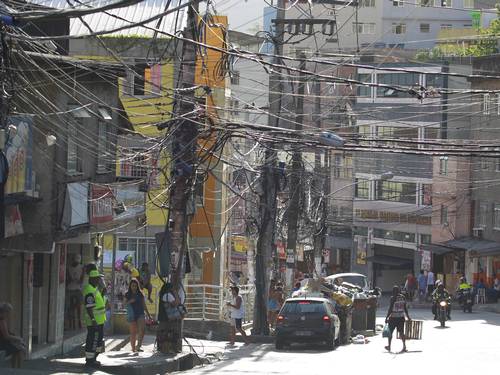 “People risked their lives to steal energy and did not take into consideration consumption levels. For the local company, these potential customers were responsible for the high level of losses and default. The social contract was broken.”
“People risked their lives to steal energy and did not take into consideration consumption levels. For the local company, these potential customers were responsible for the high level of losses and default. The social contract was broken.”
Gatos are a significant problem for Light: “as a result of the energy theft so common in the favelas, its level of non-technical losses and default reached 64.1% and 90.4%, respectively.” However, despite Lins’ suggestion, even Light’s own website acknowledges that gatos are not exclusively a problem in favelas: “Whoever thinks that the losses caused by irregular connections is only caused by favelas is very mistaken. The gato is spread across favelas and the asphalt (formal city) in equal proportion.”
With the entrance of the UPPs, Light–as well as other utility providers, such as CEDAE (state water and sewage company) and Comlurb (municipal waste management company)–were able to enter favelas and increasingly regularize their services. Light set up “new electricity measurement equipment… as well as modern and more efficient monitoring systems”–more specifically, overhauling the system of analogue meters measuring one’s consumption to digital ones, which could be monitored remotely (and electricity shut off remotely) by the company.
As well as this change, Light took various other steps to ensure a fair service could be provided to favela residents, such as investing in efficiency programs to make bills affordable. According to Lins, this was so that–apparently like children learning “right” from “wrong”–they could begin “to associate having access to a good service with paying for electricity on a regular basis” (emphasis added).
The result, for Lins, was that, thanks to Light’s endeavors, favela residents could finally achieve the citizen-rights that had so long eluded them: “Energy bills in hand, favela residents could now also open bank accounts and have access to a whole new set of economic and social opportunities…They were no longer treated as ‘informal people’ but as citizens who deserved better treatment.”
Residents’ complaints
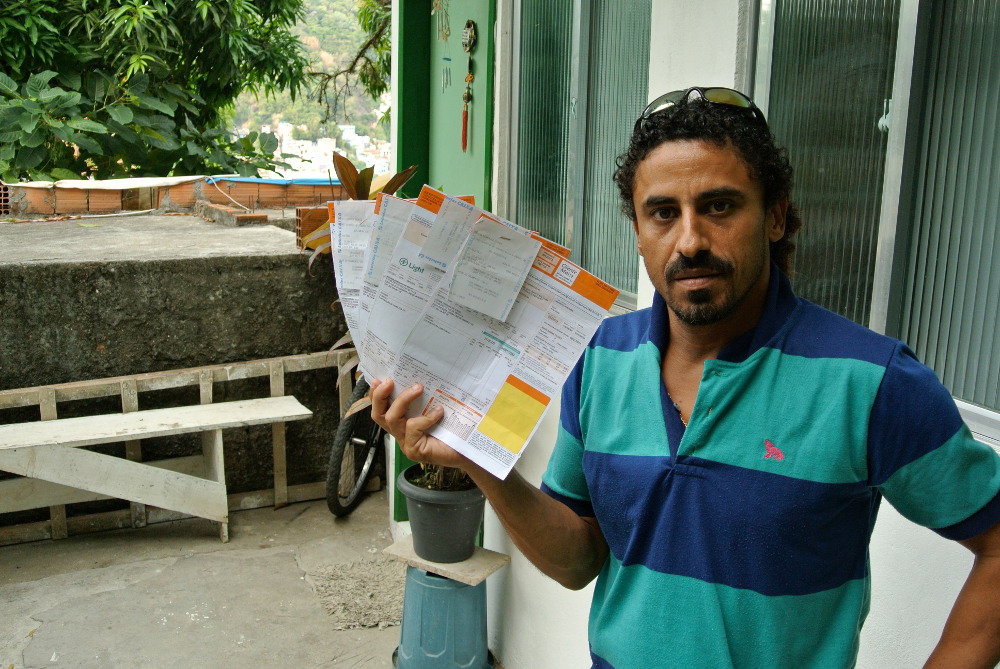 This is the official narrative of Light’s activities in UPP-occupied favelas, written by a sub-contracted employee. However, it is countered by another, coming from the residents of the favelas themselves. They complain of systematic exploitation by Light–most significantly, sharp and inexplicable rises in electricity costs, placing substantial financial pressure upon them, often not matched by an improvement in services.
This is the official narrative of Light’s activities in UPP-occupied favelas, written by a sub-contracted employee. However, it is countered by another, coming from the residents of the favelas themselves. They complain of systematic exploitation by Light–most significantly, sharp and inexplicable rises in electricity costs, placing substantial financial pressure upon them, often not matched by an improvement in services.
Gilmar Lopes, resident of Morro dos Cabritos and Tabajaras, explains how since February 2011, he has been asking Light to come and install a new meter in his property, in which he rents out numerous rooms. With the electricity to all apartments coming through one meter, “I have constant problems with blackouts [and] the cost of electricity is much higher.” Because the meter services so many people, he erroneously pays a commercial fee instead of residential one. There was also an electrical fire due to the old wires that supplied the system–“today my telephone and Internet are not working, and we went almost 12 hours without electricity.”
“I’ve tried everything,” he complains. “Dozens of people from Light have come, and they all say, ‘Oh, tomorrow we will come [to install the meter]’… I’ve explained [the problems] to everyone and the response is always the same: “We are coming tomorrow””. “After three years waiting, I can’t take it anymore, and I am suing Light because of this service that never arrives.”
Another common complaint is that public illumination often doesn’t work, despite all Light customers paying a standard fee for it. Residents from various favelas explain that if a public light fixture breaks, it takes months for someone to come and fix it, even though they continue paying for the non-existent service.
Inexplicable charging
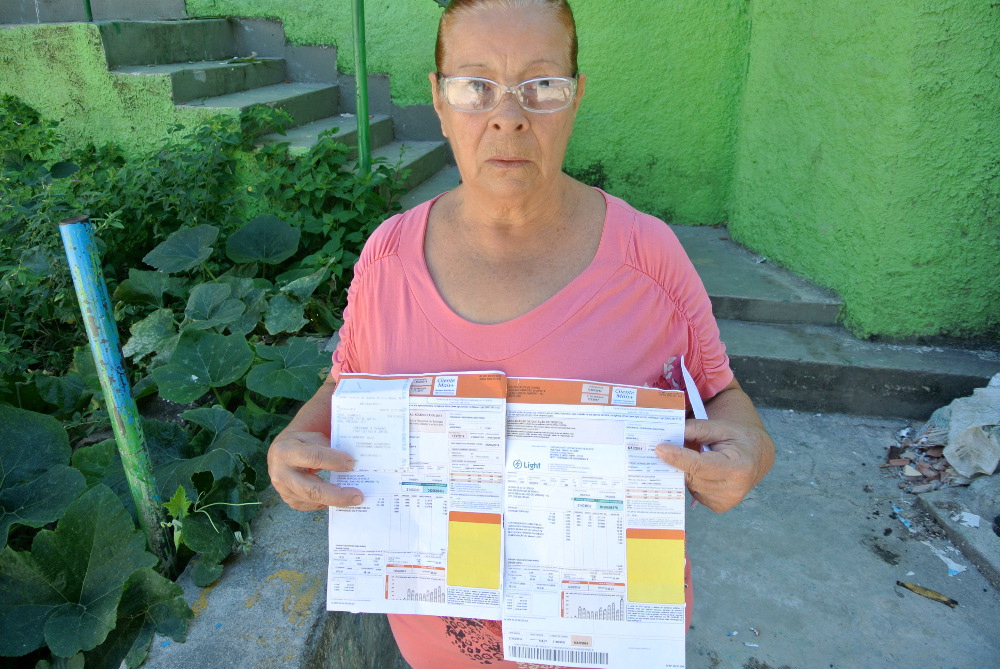 The most serious problem, however, is with the cost of bills. As in the case of Sr. Chico, many residents watch in confusion as the values rise dramatically–without any parallel rise in consumption. Gloria Silva de Souza, of Chapéu-Mangueira, paid R$48 in February; in March, her bill tripled to R$144. Paulo Sergio Medna, also of Chapéu-Mangueira, paid R$59 in November 2013. In December, this figure rose to R$311. Asked whether their consumption increased in any significant way during that period, they all answer the same way: “no.”
The most serious problem, however, is with the cost of bills. As in the case of Sr. Chico, many residents watch in confusion as the values rise dramatically–without any parallel rise in consumption. Gloria Silva de Souza, of Chapéu-Mangueira, paid R$48 in February; in March, her bill tripled to R$144. Paulo Sergio Medna, also of Chapéu-Mangueira, paid R$59 in November 2013. In December, this figure rose to R$311. Asked whether their consumption increased in any significant way during that period, they all answer the same way: “no.”
Customers are fundamentally unable to make sense of the rises, and Light does not provide any explanations to them other than the implausible suggestion that they have consumed more. Tandy Firminio, a photographer and activist from Santa Marta, explains how in the office where he works, which has three floors, numerous computers and air conditioning units, the monthly bill is roughly R$300. At home, where he does not have air conditioning, the bill often comes at the same amount. “In January 2012, I was in Recife for 20 days… Everything was switched off and the bill came higher [than usual], almost R$300. In January 2013, I was there and it also arrived high. What’s the point? Whether I’m at home or not, it arrives high in the same way.”
“There is no explanation. This is the big problem–there is no information,” states André Constantine, an activist from the Favela Não Se Cala movement and a resident of Babilônia. “So the resident despairs… because when he looks for Light, he does not get any orientation to give him guidelines about what is happening. This disinformation which Light creates is deliberate.”
 The problem appears to have begun with the installation of the new digital meters that replaced the analogue system. The customer is unable to read the meter and check how much she is consuming, therefore leaving her unable to control or monitor the amount she will be charged for. In some cases, meters are even kept in locked boxes–entirely preventing the customer from accessing them. Any problem therefore requires that a technician from Light come to check the meter–yet residents frequently complain that if they speak to Light, the solicited technician never arrives. “The anger that it creates is that they don’t come to resolve anything,” says Tandy. Light does send functionaries, he explains, but not (technicians) to check the meters–rather, to count one’s household appliances: “no, my friend, I want you to look at the meter to see what’s going on. ‘Oh, but I’m not allowed to look at the meter.’ Well, then, why are you here?”
The problem appears to have begun with the installation of the new digital meters that replaced the analogue system. The customer is unable to read the meter and check how much she is consuming, therefore leaving her unable to control or monitor the amount she will be charged for. In some cases, meters are even kept in locked boxes–entirely preventing the customer from accessing them. Any problem therefore requires that a technician from Light come to check the meter–yet residents frequently complain that if they speak to Light, the solicited technician never arrives. “The anger that it creates is that they don’t come to resolve anything,” says Tandy. Light does send functionaries, he explains, but not (technicians) to check the meters–rather, to count one’s household appliances: “no, my friend, I want you to look at the meter to see what’s going on. ‘Oh, but I’m not allowed to look at the meter.’ Well, then, why are you here?”
The new digital meters are currently under judicial review after a lawsuit was filed against their use. Prosecutor Carlos Andresano told Brasil de Fato that he wanted them changed back to the analogue meters: “We don’t want to go backwards, we want progress, but the apparatus needs to correspond with reality,” he said. “Documents prove that there is a significant rise in bills, without justification, and this served as the basis for the lawsuit.”
Indeed, a recent study of Light bills in Chapéu-Mangueira carried out by the Rio’s Pontifical Catholic University (PUC-Rio) as part of the Direitos em Movimento project, found evidence of serious wrongdoing by Light in the manner which they billed customers, potentially explaining the persistent rises. Alexandre Mendes, a law professor who led the study, summarized their findings: “Light used a strategy, after the entrance of the UPPs, to gradually stabilize consumption ceilings in bills, and gradually raise them.” In other words, they found that a large proportion of residents–as many as 78.26%–were being charged for fixed amounts of kilowatt consumption that did not necessarily correspond to their own, and that the upper limit of consumption would rise continually by 100 kilowatts per month: from 250 in March 2013, to 350 in April, and so on, until it reached 750 in August.
The implication is that many residents of Chapéu-Mangueira are not paying for their own electricity consumption, but rather for a predetermined amount–which could rise consistently and exponentially beyond their control. This is unlawful, and the study group has sent their findings to the public office that deals with the civil lawsuit against the digital meters. In the absence of explanation by Light of the irregularities, this study begs the question: in how many other favelas is this being done? Experience, unfortunately, would suggest many.
Gentrification
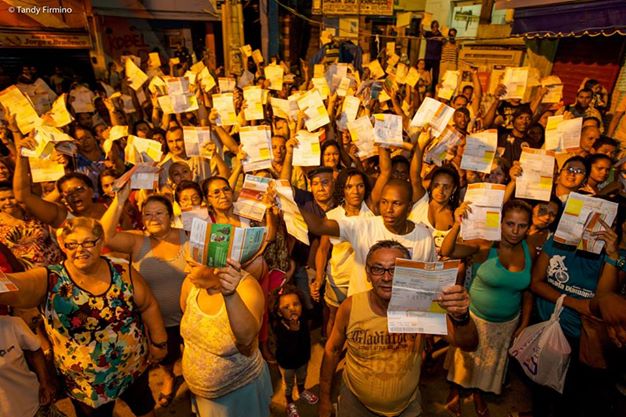 The suggestion of a deliberate and premeditated rise in electricity costs plays into a broader issue of the rise in costs of living in pacified favelas. “Residents of the favela want to pay electricity bills, they don’t want to live off the gato… [But] what does [Light] want residents to do? Go to the street and rob? Just to pay their electricity bills?” Tandy asks. “How is it that with the minimum wage [R$724 or US$320 per month] you are going to pay R$300 to Light?… For example, the minimum rent here in the favela is R$500, if he pays R$200 for electricity it’s already finished, so what’s he going to eat?”
The suggestion of a deliberate and premeditated rise in electricity costs plays into a broader issue of the rise in costs of living in pacified favelas. “Residents of the favela want to pay electricity bills, they don’t want to live off the gato… [But] what does [Light] want residents to do? Go to the street and rob? Just to pay their electricity bills?” Tandy asks. “How is it that with the minimum wage [R$724 or US$320 per month] you are going to pay R$300 to Light?… For example, the minimum rent here in the favela is R$500, if he pays R$200 for electricity it’s already finished, so what’s he going to eat?”
To many, the increase in values of bills is part of a broader phenomenon of gentrification or “white removal” as it is known locally. “We know this is not a problem of human failure. We know it’s not a random problem–it is intentional, it is deliberate,” says André. With the entrance of the UPPs quickly came, before investment in education, sanitation or health, the regularization and the formalization of market-based services such as electricity. “Today Light hides itself behind the UPP, in order to implement a system that simplifies its own life, but is not good for residents,” complains Gilmar. In stark contrast to Lins’ purported “social contract,” Gilmar says, “I don’t see a relationship that brings any benefit to the community.”
Protest
On Tuesday (March 25) residents of Santa Marta took to the streets to protest Light’s abuses in their community, blocking off Rua São Clemente, one of Botafogo’s main arteries. Light’s response, as reported in O Globo, was feeble and lacked credibility: “the rise in consumption is due to the elevation of the temperature, which resulted in rates higher than the clients’ expectations.” But many have had enough, and resistance, in the form of a movement for a single, fixed rate for favela residents, is taking shape. “We need pressure in the federal sphere, to force the federal government to implement a social rate for all,” stated André.
Residents are determined that Light’s impunity and exploitation of the favelas, arbitrarily raising costs all while providing faltering services, does not continue. As Tandy explained, “our plan is the following: unite all of the favelas, do a march, go to Brasília, and begin to stir things up, because we need a single rate.”
